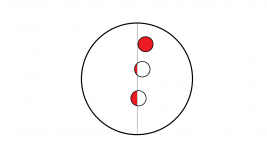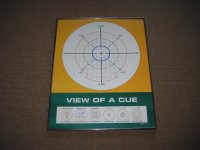Many of you will be familiar with TOI, but to those who are not, a little explanation will be necessary. So basically, what it entails is to cue shots with a little bit of inside spin, quite firmly, and aim to the thick part of the pocket. Because of deflection, the cueball will be thrown to the side a bit and make the ball in the center, if you hit where you aim. If you hit the center instead, you'll still pocket the ball and you will also pocket the ball if you hit a little bit more inside than intended.
This may seem unnecessarily complicated. Why not play center ball, aim for center pocket and just take advantage of the margin of error? Well TOI has some advantages. One of the most important ones, is that the cueball behaves a bit more consistently. Putting outside on the cueball by accident seems to make it run away more, while center or inside floats the ball in a more controlled fashion (to me). The method more or less guarantees that the ball will never have outside on it (if your cueing is good).
Another great advantage is that you are using spin to cut the ball more. In my experience, the closer to straight in a shot is, the easier it is to aim. On some shots you are dealing with optical illusions as well. Certain narrow angles into the side seems to draw the ball into the point, and it's difficult to get a feel of where the pocket opening is. I sometimes deal with that by aiming to brush the point and then put inside on, to make sure I miss it. The margin of error on some of these shots is almost non-existant, but you take advantage of aiming at a place you can see and know you can hit, and then use the spin to avoid it. I use outside this way too, sometimes, but then of course the effect is in reverse.
There are drawbacks to this, the most important is: you cant really shoot slowly. You need to put some pace on the ball for the system to work. Any kind of elevation will also complicate things. It's a method for normal cueing and potting.
Most people will put way too much side on, and this is the point of this whole post, the amount of side needed is ridiculously small. Indirectly this will show you how hard it is to hit a pure center ball! Most people neglect their cueball, by not striking it with the accuracy needed. They get inconsistent potting and bad cueball control. Look at the illustrations bottom tip: This is how little side is needed on a lot of shots, some require even less! The bottom one, not the two above. So when people whine about this being too difficult, they don't realize that cueing is ALL READY this difficult, they just have no clear idea on how to work with the physics, instead of against it. They try to hit the center, which is much like trying to hit a razors edge with the edge of another razor, and then they have no idea why they miss, or lose the cueball, because they're sometimes left and sometimes right and have no clear explanation why it happens. "I must have aimed the shot wrong". No your aim on the object ball was correct, you just didn't hit the cueball where you intended.
Do I hit TOI on every shot? No, not even close. Combinations, elevated shots, slow rollers, jumpshots, shots dead straight in..typicall I don't use it on these. But I do use it a lot, especially on power shots along the rail on tough tables. It gives the confidence to slam these in, knowing that you won't brush the rail at all. Tight position shots, tricky shots into blind pockets, shots I for some reason don't feel confident about because of tight pockets or other factors. All those shots I like to use TOI on, when that gives me decent position (which is a lot of the time). Of course the position benefits are significant on all sorts of shots, even in snooker and chineese 8 ball with different pocket designs. It doesn't really limit position plays as much as you might think, you get all the standard vertical center options, with the added advantage of accuracy and a slower moving cueball. In general I try not to cinch balls, but TOI is a lot different than hitting every shot with low outside or similar. In reality it's almost identical to center ball striking. And if you need a lot of inside, or outside, you will learn to control these better than ever before, because you are more aware of the fine nuances (IMO).
This may seem unnecessarily complicated. Why not play center ball, aim for center pocket and just take advantage of the margin of error? Well TOI has some advantages. One of the most important ones, is that the cueball behaves a bit more consistently. Putting outside on the cueball by accident seems to make it run away more, while center or inside floats the ball in a more controlled fashion (to me). The method more or less guarantees that the ball will never have outside on it (if your cueing is good).
Another great advantage is that you are using spin to cut the ball more. In my experience, the closer to straight in a shot is, the easier it is to aim. On some shots you are dealing with optical illusions as well. Certain narrow angles into the side seems to draw the ball into the point, and it's difficult to get a feel of where the pocket opening is. I sometimes deal with that by aiming to brush the point and then put inside on, to make sure I miss it. The margin of error on some of these shots is almost non-existant, but you take advantage of aiming at a place you can see and know you can hit, and then use the spin to avoid it. I use outside this way too, sometimes, but then of course the effect is in reverse.
There are drawbacks to this, the most important is: you cant really shoot slowly. You need to put some pace on the ball for the system to work. Any kind of elevation will also complicate things. It's a method for normal cueing and potting.
Most people will put way too much side on, and this is the point of this whole post, the amount of side needed is ridiculously small. Indirectly this will show you how hard it is to hit a pure center ball! Most people neglect their cueball, by not striking it with the accuracy needed. They get inconsistent potting and bad cueball control. Look at the illustrations bottom tip: This is how little side is needed on a lot of shots, some require even less! The bottom one, not the two above. So when people whine about this being too difficult, they don't realize that cueing is ALL READY this difficult, they just have no clear idea on how to work with the physics, instead of against it. They try to hit the center, which is much like trying to hit a razors edge with the edge of another razor, and then they have no idea why they miss, or lose the cueball, because they're sometimes left and sometimes right and have no clear explanation why it happens. "I must have aimed the shot wrong". No your aim on the object ball was correct, you just didn't hit the cueball where you intended.
Do I hit TOI on every shot? No, not even close. Combinations, elevated shots, slow rollers, jumpshots, shots dead straight in..typicall I don't use it on these. But I do use it a lot, especially on power shots along the rail on tough tables. It gives the confidence to slam these in, knowing that you won't brush the rail at all. Tight position shots, tricky shots into blind pockets, shots I for some reason don't feel confident about because of tight pockets or other factors. All those shots I like to use TOI on, when that gives me decent position (which is a lot of the time). Of course the position benefits are significant on all sorts of shots, even in snooker and chineese 8 ball with different pocket designs. It doesn't really limit position plays as much as you might think, you get all the standard vertical center options, with the added advantage of accuracy and a slower moving cueball. In general I try not to cinch balls, but TOI is a lot different than hitting every shot with low outside or similar. In reality it's almost identical to center ball striking. And if you need a lot of inside, or outside, you will learn to control these better than ever before, because you are more aware of the fine nuances (IMO).
Attachments
Last edited:

